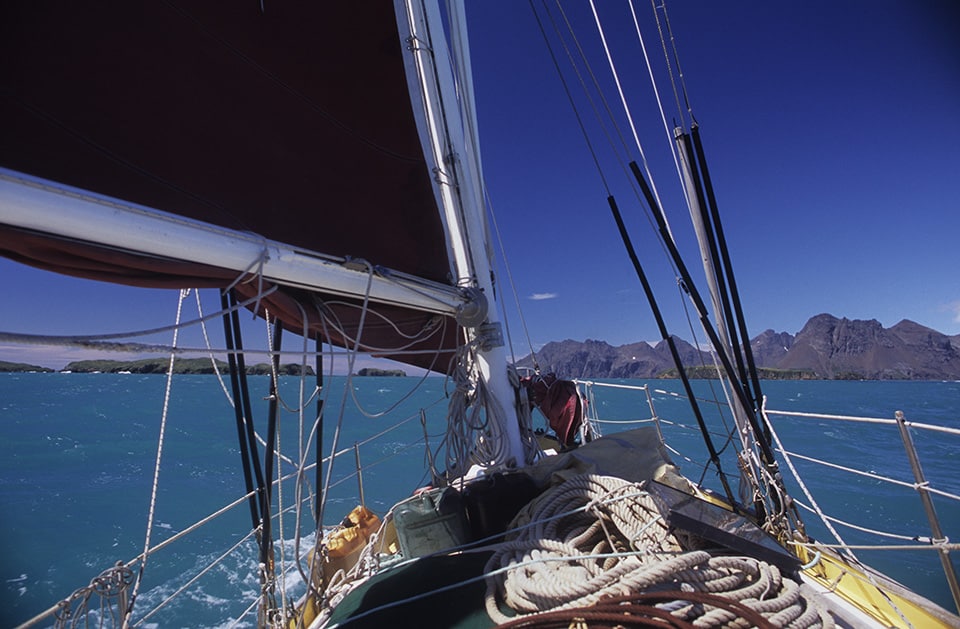
Classic circumnavigators as we knew them—are they, or are they not, becoming a rare, dying breed? By classic, I mean leaving home, continuously sailing the entire trade-wind circuit, and arriving back at the same spot within a set time. The temptations and fulfillments of a circumnavigation under sail used to sit firmly within this construct. Typically, it would take at least three years. By the end, one was now somebody: a salty sea dog with that faraway look in one’s eye.
No doubt: Once a globalizer, now the circumnavigator is overtaken by globalization. Via the Internet, one can see distances dissolve; via the media, novelty crumbles. The exotic becomes common. The most attractive areas are packed with charter boats. Hardly a coast is lonely, free, or affordable. In short, what the long-distance sailor dreamed of no longer matches reality. Circumnavigating has lost its charms, some would say.
But can this be true, that a circumnavigation following the trade-wind Milk Run is passé? That the measured pace it takes has no allure? Has the world today grown so familiar? Is the time it takes to circle it now much too long?
Numbers tell us that only a fifth of the members of the German cruising association Trans-Ocean are on a round-the-world voyage. Only 16 percent of those who join the Atlantic Rally for Cruisers want to continue westward from the Caribbean. Cruising, as a reflection of affluent society, today favors immediacy, consumption, and fun; this, in turn, favors chartering or racing or perhaps a year in the Med, a circuit to the Caribbean, or bluewater voyages done in short hops.
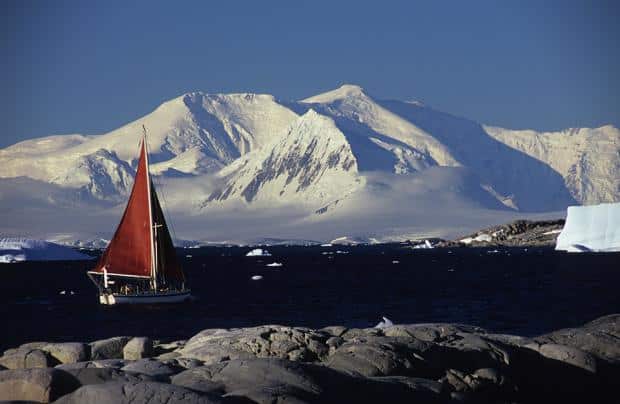
But to conclude from this that there are fewer boats roaming the planet would be a mistake. It’s just that among the increasing number of ocean cruisers, fewer are circumnavigating in the classic manner.
Very early in life, I wanted my own boat to sail around the world. But not quickly, not with others, not as a party trip, not on a race, not to set a record. Just to experience the planet, in all its variety. As a 13-year-old, I was infected by the circumnavigation dream; as a 19-year-old, by wooden boats. At 24, I owned Wanderer III, and since then I’ve hardly had a penny.
The round-the-world myth, which held me in its grip, stemmed from a time when there was hardly a sailor backed by any capital. Sterling Hayden, the Hollywood hero sailing aboard his ex-San Francisco pilot schooner Wanderer in Tahiti, thundered out sentences like “To be truly challenging, a voyage, like a life, must rest on a firm foundation of financial unrest.” The Hiscocks’ motto, carved into Wanderer III‘s companionway, reads “Grab a chance and you won’t be sorry for a might-have-been.”
The boats were small, the sailable world large, the route usually in the tropics. The oceans were crossed without safety nets; in most remote areas, the knack for improvisation counted more than money. Three-quarters of the globe was relatively pristine ocean, a veritable rejuvenator, an unspoilt melting pot, not only for sea dogs and vagabonds but also for the couple from next door who’d succumbed to sailing wholeheartedly. As different as their reasons may have been, round-the-world sailors seemed a homogenous bunch, cloaked in the myth of independence. Such voyages didn’t draw the masses. Nobody counted the years they took; on the contrary, the longer the voyage, the greater the kudos. As a matter of fact, they were story collectors. And that was what I wanted to become. To me, such a circumnavigation required spunk and magic. Self-determination riding on my own planks; I couldn’t imagine it any other way.
But other ways exist today, and in many variations. Nowadays, a young person can quite easily fly somewhere and be fairly sure of finding work as crew on a large yacht. It’s a sunny life. With some luck, you’ll land on a boat that moves a lot. One earns a good living and soon gets accustomed to large dimensions. Many 20- and 30-year olds who feel the intense urge to go to sea that I had back then choose this lucrative path. If you then want to add a circumnavigation, you’ve seen much of it already.
It’s been many, many years since I’ve been to the tropical maritime hot spots of Tahiti, Tonga, or the Caribbean, so I haven’t needed to ask myself, “What am I doing here, on my own boat, among all these charter yachts?” But in other places, I’ve felt economic realities play a role in my own voyaging. Yachting infrastructure now spans the globe. It’s no longer a problem to get a mast flown around the world or to leave your boat safely somewhere. With easy GPS navigation and total connectedness via satphone and the Internet, one would think that global sailing would be as attractive as never before. Indeed it is—but as a part-time venture, not in its classic form.
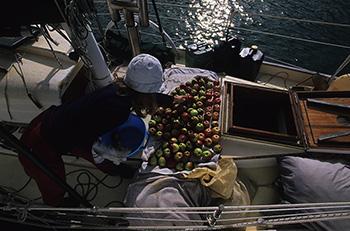
This has come about because of a modern paradox. To be unconnected is totally unthinkable for anybody who grew up with modern communication technology. Modern sailors can no longer imagine it. Yet, precisely because you can stay connected with home, you—out cruising on the blue—are more likely to give in to the option to return home when the urge hits you. Precisely because you stay mentally connected with home, you return there physically more easily. Because the faraway immerses you less into its “now,” you connect less to its attractions. Because life aboard no longer demands privations, because sailing no longer equates with limiting yourself, it perhaps doesn’t require the same dedication—this profound
decision to go, to set off, to leave behind—that can’t but come with a tone of renunciation.
Just like someone sailing in home waters, the modern circumnavigator becomes a part-time sailor who jets back and forth. Flying has become a part of bluewater sailing, just like the compass. It’s rare, nowadays, for flying not to be an integral part of cruising.
This tendency toward part-time voyaging fills foreign bays with boats. And anything that grows noticeably popular loses its allure in the end. Yogi Berra once said, famously, “Nobody goes there anymore. It’s too crowded.” A potential circumnavigator may pay heed and decide to sail closer to home and for shorter durations. This way, the sailor can also keep pace with the demands of a career.
There may come a time when Hollywood decides to glorify on screen the era of the Haydens, Hiscocks, Smeetons, and Moitessiers—the wanderers of the world—as it did with the Wild West, where freedom actually only lasted a couple of decades. The fences across the prairie came quickly, quicker than Hollywood would have us believe. The many people, the many boats, the big world made much smaller—I see a parallel here. The era of footloose voyaging, as it evolved from the 1950s through the early 1980s, is more and more becoming cruising that’s bound toward a reeflike maze of regulations.
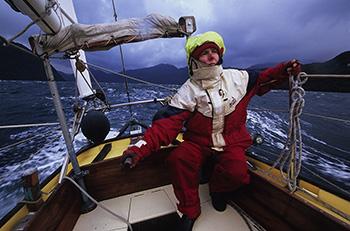
According to the Old Salts, the Caribbean of the early 1970s was the most fantastic sailing area in the world. It held the perfect mix: wind and warmth, great anchorages, easygoing locals, and just enough infrastructure. It was easily accessible by boat or plane from Europe and the States. And the original Sea Dogs were still likely to pop by.
When I arrived in the Caribbean in the mid-1980s, the Atlantic Rally for Cruisers had just newly transplanted a piece of Europe across the Atlantic. The extra sailors went more or less unnoticed in a Caribbean that was already undergoing a charter boom. That Jimmy Cornell’s ARC had turned bluewater sailing into a business wasn’t a worry to anyone there.
But something huge was indeed taking place: a transformation of the ethos of bluewater sailing. The ARC totally redefined the concepts of independence, adventure, and self-sufficiency. Ideals shifted. Paying for inclusion implied some sort of greater safety in crossing the mighty ocean. One paid for camaraderie, for familiarity, and perhaps to help convince a spouse it was safe to go.
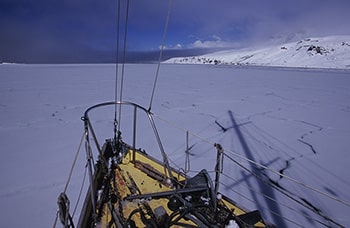
This struck me as strange. Wasn’t the whole point to do it on your own and for yourself, not so that you had half of London with you? How can you fulfill your longing for the foreign and exotic when you head there in a herd? Cruising became more a social event among peers than a discovery of other worlds.
Next to sun and sail, maybe all some want from the world is a carefree backdrop, colorful décor, and ice-cold beer around 1700—the Caribbean as Muzak, soothing as it plays in the background. I look for more. No doubt, I had a great time in the Caribbean, much of it among first-generation have-a-good-time cruisers still hanging around from the late 1960s. I hung out easily, much of the time with wooden boaties. Yet, back then, I couldn’t help feeling that a circumnavigation didn’t really start until Panama. And now?
Of course, we still exist, we bluewater voyagers, classic circumnavigators, work-ourselves-around-the-world cruisers. Just probably less so on the classic routes, and overall, we’re much out-numbered. Some of us have made a latitudinal shift of 30 or 40 degrees north or south and now go sailing in other places, in areas that used to lie outside our mental reach.
A French family on a 50-foot aluminum sailboat, a Czech singlehander on a 36-foot steel boat, and my wife, Kicki, and I on 30 feet of wood: Not long ago, we all met in an icy bay at 54 degrees south. We shared much common ground: Our boats were relatively simple, and we repaired them ourselves. None of us was well-heeled; all of us had, at one point, spent time in the Caribbean to replenish the kitty. The French couple had raised their children on board and had chosen, like us, a life at sea. The Czech was inspired by David Lewis’ book Ice Bird; his aim was to circumnavigate the Southern Ocean.
An evolutionary process had brought us together. In that sense, our meeting wasn’t entirely coincidental. Forty years ago, the likes of us would probably have met in Tahiti, and we would’ve been the only ones. Twenty years ago, just prior to the arrival of GPS, we might’ve met in the difficult-to-navigate Tuamotus. Nowadays, we meet in the bays of the higher latitudes. And even here one finds the adventure often substantially cushioned by security and communication networks.
But challenges, if one wants them, can be found anywhere. For every decade of life, for every boat, for every person there exists a particular Cape Horn. One sailor may cruise in advanced age, another on a tiny boat. Our own method lies in reduction: own few things, carry little technology, enjoy less certainty. This gives the world, and what we experience in it, a wonderful intensity. It sharpens reality. It brings to life a sense of wonder.
In order to meet the world in such a light, you must experience the present and live in the moment as openly as possible. Nobody forces you to sail to the hot spots, into the most easily reached areas. Nor must you sail in groups. And, once under way, you’ve usually got the ocean to yourself. There may be nothing overwhelmingly outlandish anymore in this world, but the exotic is still there. It exists in a microcosm. As stories. As your own stories. As personal tales of the beauty and exhaustion, which merge into one. You simply have to pick them up.
Just before Kicki and I sailed into the Antarctic, a friend who’d been there many times said to us, “I envy you. I envy you the experience of seeing it for the first time. Nothing can beat it.”
Whether Antarctica, the Milk Run, or the Caribbean, the challenge is to search for the First Time. You can find it, everywhere. Actually, it’s quite easy.
Thies Matzen and Kicki Ericson are the 2011 recipients of the Cruising Club of America’s Blue Water Medal and the Award of Merit from Great Britain’s Ocean Cruising Club.








